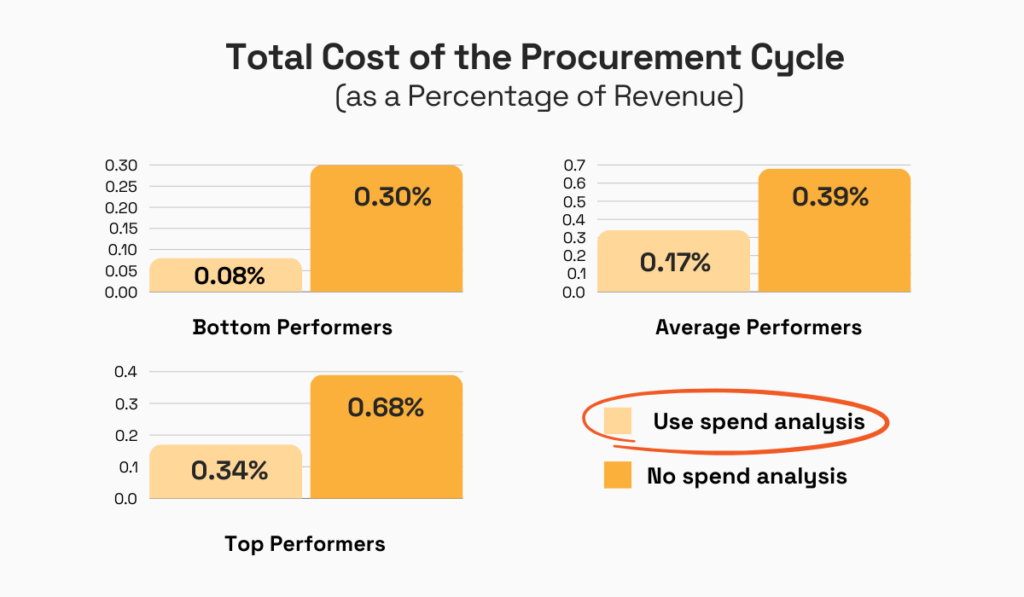Spend Management vs Spend Analysis: Key Differences


Understanding how and where a company spends money has always been a priority for CEOs, CFOs, CPOs, and procurement professionals alike.
Two key concepts often discussed in this context are spend management and spend analysis.
While related, these concepts serve distinct, yet complementary roles in making procurement processes more effective and cost-efficient.
In this article, we’ll define both spend management and spend analysis and then break down the key differences between them.
So, join us as we explore how these two work together to improve your company’s spending.
Spend management is an umbrella term that covers all the processes, activities, and tools used by companies to manage their expenditure.
When we consider this broad definition, it becomes clear that spend management—in addition to spend analysis—includes processes like:
Given the variety and complexity of these processes, it’s no surprise that many organizations face significant challenges in managing their spend efficiently.
What challenges, you ask?
Here’s what respondents in Payhawk’s 2024 Spend Management Pulse Report highlighted as the top obstacles:

Illustration: Veridion / Data: Payhawk
Collectively, these spend management issues highlight how manual processes and fragmented systems can lead to inefficiencies, errors, and compliance challenges.
For instance, when a company’s spend data is scattered across multiple software systems, departments, and locations, it becomes difficult to get a unified view of total spend.
Without integration, errors are more likely to go unchecked.
This further compromises data accuracy and makes it hard to manage spend effectively.
Addressing these challenges typically requires greater process automation and real-time data visibility to ensure a comprehensive understanding of spending, particularly in procurement operations.
This is supported by findings from Amazon Business’s 2024 State of Procurement Data Report:

Illustration: Veridion / Data: Amazon
This willingness to invest in procurement tools is directly linked to achieving more efficient spend management.
Remember all the components of spend management we listed, from budgeting to procurement compliance monitoring?
Well, this abundance of functionalities means a company typically needs to implement a range of mutually integrated spend management and procurement automation solutions.
For example, you might use a comprehensive spend management platform like Payhawk.

Source: Payhawk
Such all-in-one solutions enable you to digitize and automate many spend management processes, including purchase requests, approvals, order processing, and more.
However, depending on your organization’s specific needs, they might not be sufficient on their own.
For instance, tools for supplier discovery, risk assessment, contract management, or advanced spend analytics can complement and enhance your spend management system.
All in all, the right combination of digital solutions, proper procedures, and staff buy-in can transform your spend management and generate benefits like:
To this point, Coupa’s 2024 Benchmark Report highlights a clear correlation between efficient spend management and higher cost savings.
Namely, the research found that high-performing companies in 2023 saved an average of 5.8% of their overall spend, compared to 2-3% saved by their average-performing peers.

Illustration: Veridion / Data: Coupa
This demonstrates the tangible advantage that top performers achieve through effective spend management.
To sum up, spend management encompasses various processes, methods, activities, and tools that, when properly aligned, deliver measurable results.
These outcomes go beyond cost savings, driving operational excellence and long-term strategic value for your organization.
Now, let’s explore the role of spend analysis in this process.
While spend management takes a broad approach to controlling how money flows through an organization, spend analysis focuses on understanding and optimizing that flow.
The process involves collecting and consolidating spend data from various sources, its cleansing and categorization, and then conducting an in-depth analysis.
Spend analysis can be defined in the following way:
“Spend analysis is the process of reviewing current and historical spending to reduce costs, increase efficiency, and improve sourcing and supplier relationships.”
In other words, it digs deep into your spend data to identify patterns, trends, and opportunities for improvement.
To gain a clearer picture of your company’s spending, spend analysis examines several critical elements, each answering key questions like the ones in the visual below.

Source: Veridion
It’s important to note, however, that not all spend analyses are the same.
What we mean by that is, spend analysis can be:
In any case, it plays a pivotal role in optimizing procurement and improving overall business performance.
By providing visibility into spending patterns, it enables companies to make informed decisions that go beyond simply cutting costs.
As illustrated below, the benefits of implementing spend analysis are substantial:

Source: Veridion
Let’s take improved visibility into your organization’s finances as an example.
It allows you to track expenditures across departments, categories, and suppliers, and gain valuable insights.
For instance, a company might discover that certain departments are overspending on office supplies, which can be corrected by centralizing purchases.
Another key benefit is minimizing unnecessary spending.
Through detailed analysis, your team can identify redundant purchases and maverick spending.
For example, you might notice that multiple departments are independently purchasing the same items when a bulk purchase or enterprise agreement could result in significant savings.
The bottom line is, the benefits of spend analysis are evident in organizations that regularly conduct it.
And, as you can see below, this is supported by APQC’s research on the total cost of the procurement cycle.

Illustration: Veridion / Data: APQC
This difference in total procurement cost, expressed as a percentage of revenue, highlights the measurable impact of effective spend analysis on cost reduction.
But aside from discussing these tangible benefits of spend analysis, we’d be amiss not to mention the challenges that teams may encounter when conducting it.
The primary obstacle to conducting detailed spend analysis is the variety of spend data sources and the accuracy of that data, or lack thereof.
How so?
Well, when spend data is inaccurate, outdated, or missing, it can skew the analysis results.
This leads to incorrect insights, missed cost-saving opportunities, and increased compliance risks.
Another significant pitfall is the reliance on predominantly manual methods for spend analysis, such as spreadsheets, non-automated internet searches, and non-centralized data access.
These approaches make the process of analyzing spend data more time-consuming while also increasing the risk of errors, inefficiencies, and distorted outcomes.
Despite this, as Forrester’s research has shown, many organizations continue to rely solely on manual methods, or a combination of manual and automated methods.

Illustration: Veridion / Data: Incisive
The above figures indicate that 80% of companies would benefit from adopting tools that allow them to move away from spreadsheets and non-integrated data sources.
As we mentioned, there’s a variety of company-wide or procurement-specific spend management platforms that can help automate the analysis process.
Such tools allow you to integrate various data sources in one place, clean and classify the data, analyze it, and gain real-time insights into your company’s spend.
As the volume of spend data grows over time, it becomes essential to invest in digital tools needed for efficient spend analysis.
To recap, spend analysis is a process that involves collecting, classifying, and analyzing spend data to generate insights that drive cost reductions, efficiency gains, and improved supplier management.
Now that we’ve outlined what spend management and spend analysis entail, let’s highlight the key differences between them.
If you didn’t skip to this part, it should be clear that spend analysis is a key component of spend management.
In the words of Patrick Reymann, Director of Strategic Sourcing Operations at Corbus:
“Spend analysis is actually a subset of spend management. A meaningful spend management engagement is impossible without a detailed and accurate spend analysis program.”
However, although these two concepts are interconnected, they differ in scope, activities, and goals.
Let’s explore this in more detail.
Spend management is a broader, end-to-end process that encompasses all activities involved in managing and controlling an organization’s expenditures.
As such, it covers the entire procurement cycle, from identifying the need for goods or services to negotiating with suppliers and ensuring compliance with contracts.
Spend management takes a holistic approach that focuses on managing or influencing your company’s addressable spend.
Here’s how addressable spend fits within your company’s total spend.

Source: Veridion
For spend management to be effective, companies need to determine their total spend, identify non-addressable expenses, and establish which expenditures are already managed by procurement.
And this is precisely what spend analysis enables them to do.
It focuses specifically on the collection, categorization, and examination of historical expenditure data.
By examining past or current data, it uncovers trends and patterns in spending, supplier usage, and procurement practices.
Overall, the scope of spend management includes spend analysis as a key component that provides critical insights needed to make informed spending decisions.
As we learned, spend analysis is essentially one of the activities that underpin effective spend management.
Depending on its type and objectives, spend analysis can be a one-time, periodic, or even—with the help of real-time spend analytics tools—a regular activity.
Regardless of its frequency, spend analysis focuses on data collection and analysis, involving activities such as data gathering, cleansing, categorization, and classification.
Expectedly, these activities are best entrusted to spend analysis software and well-trained analysts.

Source: Sievo
Keep in mind that your spend analysis solution can be a standalone product, or a feature integrated within your spend management or procurement software.
As for spend management, this is a continuous process that involves many activities, such as:
As explained, spend management activities also include analyzing spend data to identify potential cost savings and process improvements.
Lastly, let’s not forget activities like assessing procurement risks, generating spending reports, and forecasting future expenditure needs.
Given the scope of activities that spend management covers, it’s not surprising that companies use different tools to ensure comprehensive support for all procurement needs.
For instance, our AI-powered procurement solution, Veridion, enables you to find new suitable suppliers within seconds, enrich your supplier profiles with weekly data updates, and assess and monitor supplier risks and market conditions.
Plus, our global supplier database with over 100 million companies is updated weekly.

Source: Veridion
That way, you can be sure that your spend analysis and procurement management solutions are working with the latest data.
This is crucial for more than just accurate spend analysis, though.
It’s also key for evaluating existing and prospective suppliers across a range of criteria, as well as monitoring supplier-unreported risks.

Source: Veridion
With such tools in place, procurement teams can reduce risks and make more informed sourcing decisions, leading to cost savings and more effective spend management.
Now that we’ve covered the differences in activities, let’s touch upon the distinct goals of spend management and spend analysis.
We could say that differences in the nature and scope of spend management and spend analysis shape their goals.
The main goal of spend management is to control and optimize company-wide spending by:
In contrast, the goal of spend analysis is to understand spending patterns by identifying areas of overspending, inefficiency, or non-compliance.
As such, it serves as a diagnostic tool that provides the data needed for informed decision-making.
However, it does not, on its own, set the strategic direction for managing or optimizing spend.
We hope that the detailed breakdown provided in this article has left you with a better grasp of the key differences between spend management and spend analysis.
While these two concepts are closely interconnected—spend analysis being a subset of spend management—they serve distinct purposes within procurement.
When all the related processes and activities are well-managed and supported by the right tools, they empower your organization to drive cost savings, improve efficiency, and ensure compliance.
Ultimately, effective spend management and accurate spend analysis lead to stronger procurement strategies and better financial outcomes for your company.
And isn’t that exactly what you want?